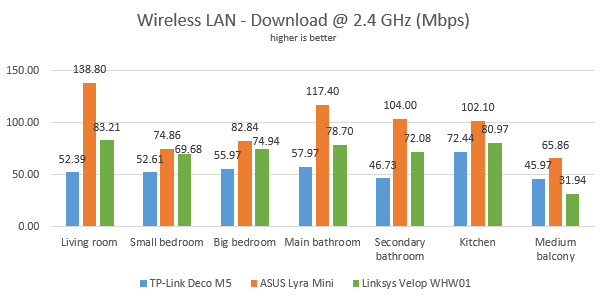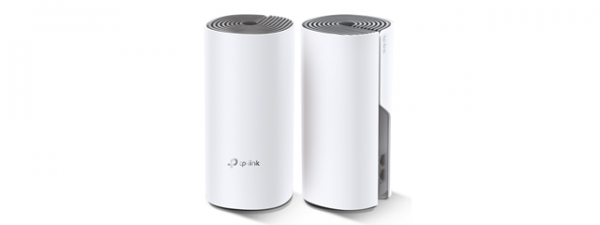
Wireless network performance
First, let's take a look at the apartment that was used in our testing and how it is set up. You can see that the central Linksys Velop hub is placed in the living room. When using wireless routers, the signal strength is not that high in rooms like the Kitchen and the Medium balcony. To improve the coverage of the network, we placed the second Velop hub in the hallway, close to the entrance to the Kitchen, to cover most of the apartment, as best as possible.
Our testing was done using a fast 1 Gigabit Internet connection that is capable of uploads on the internet of up to 500 Mbps. We used an HP Spectre 13 laptop for our measurements.
We decided to compare the Linksys Velop WHW01 with two competing mesh systems: ASUS Lyra Mini (this system uses the same processor as the Velop) and TP-Link Deco M5.
We started by evaluating the 2.4 GHz wireless network and measured the signal strength offered in each room, using a tool named NetSpot Pro. As you can see in the graph below, Linksys Velop WHW01 was the weakest in this comparison.
Then, we used SpeedTest to see how fast the internet connection is when using the 2.4 GHz wireless frequency. Velop WHW01 delivered fast downloads, without being the fastest system that we tested.
When measuring the upload speed, Velop WHW01 was almost always behind the ASUS Lyra Mini.
Next, we used the PassMark Performance test to transfer data between two computers connected to the network, using the 2.4 GHz wireless frequency. Velop WHW01 was behind the ASUS Lyra Mini.
You can see the evolution of the upload speed, in the graph below. ASUS Lyra Mini was faster in this test too.
When using the 2.4 GHz wireless frequency, Linksys Velop WHW01 is outperformed by competing systems with similar hardware. It is not slow, but it is not the fastest either.
Next, we analyzed the performance offered by the 5GHz wireless network. First, we looked at the evolution of the signal strength, from room to room. This time, Linksys Velop WHW01 outperformed ASUS Lyra Mini.
Next, we ran SpeedTest to see how fast the internet connection is on the 5GHz band. To see the maximum potential of Linksys Velop WHW01, we used the world's only PCI-E network card with support for 4x4 MU-MIMO. When we used this network card, we obtained a maximum speed of 504.15 Mbps for the download, and of 432.38 Mbps for the upload. This result is similar to that of the more expensive Velop WHW03.
For more down-to-earth results, we also measured the download speed with SpeedTest, in every room of our test apartment, using our HP Spectre 13 test laptop. Linksys Velop WHW01 was the fastest mesh only in the room where we placed the main station. In most rooms, it outperformed TP-Link Deco M5.
A similar trend was noticed when measuring the upload speed with SpeedTest.
For the last measurements on the 5GHz wireless network, we used the PassMark Performance test to transfer data between two computers connected to the network. The download speed offered by Linksys Velop WHW01 was fast in almost all rooms, but it was outperformed by TP-Link Deco M5.
When looking at the upload speed, Linksys Velop WHW01 was our speed champ, behaving similarly to its more expensive brother: Linksys Velop WHW03.
Linksys Velop WHW01 offers fast wireless connections on the 5 GHz wireless band but is not the fastest mesh system that we tested.
Wired network performance
To test the quality of the wired Ethernet connection, we used a desktop PC equipped with an AMD Ryzen 5 1600 processor, running at 3.20GHz, 16GB of RAM, a fast Samsung 850 Pro 512GB SSD, and a Lenovo IdeaCentre 610s mini PC.
We measured the speed of the internet connection when using a 1 Gbps Ethernet cable, using SpeedTest. Velop WHW01 was the second fastest mesh system in our comparison, after ASUS Lyra Mini.
Then, we ran a network transfer between the two computers, each connected with an Ethernet cable to a different Velop node. Since the stations were connected to each other wirelessly, the transfer was mediated through WiFi. We used PassMark Performance test for this measurements. As you can see, Linksys Velop had decent performance but it was not the fastest mesh system in our comparison.
You can enjoy 1Gbps connections just on one Ethernet port, on the main Linksys Velop WHW01 station. On all the others you get less, unless you connect all hubs using Ethernet cables.
Extra features
Linksys Velop WHW01 offers some extra features. The most important tools it does not have, are antivirus protection, intrusion prevention, and cloud-based parental controls. Other mesh systems offer these features, at least for a limited time. Others offer them for the whole life of the product.
Here is what you do get from:
- Guest Access - you can activate a separate wireless network, with a different name and password, for your guests.
- Speed Check - run a speed test to see how fast your internet connection is.
- Parental Controls - a basic set of manual controls and rules. It is not as competent or friendly to maintain as the cloud-based solutions offered by the competition.
- Device Prioritization - you can set which devices get prioritized on your network, for improved network speed and coverage.
- Port forwarding - you can set rules for single port forwarding, port range forwarding, and port range triggering.
- Amazon Alexa - if you use Alexa, you can control Linksys Velop through voice commands like: "Alexa, ask Linksys What is my Wi-Fi password?."
- Troubleshooting - a set of troubleshooting tools that help you figure out how to solve networking problems. Most of them can be accessed and used only from the web-based administration user interface.
Linksys Velop WHW01 offers fewer extras than the competition. Its most significant downsides are the lack of antivirus protection and that of an intrusion prevention system.
What is your opinion of the Linksys Velop AC1300 (WHW01)?
Now you know our opinion about the Linksys Velop WHW01 model. You also know how it performed in our testing, and the features that it has to offer. Before closing this review, we would like to know your perspective. Especially if you bought this mesh system, tells us about your experience with it. Other readers want to know about it before making their purchasing decision.


 31.08.2018
31.08.2018 

















